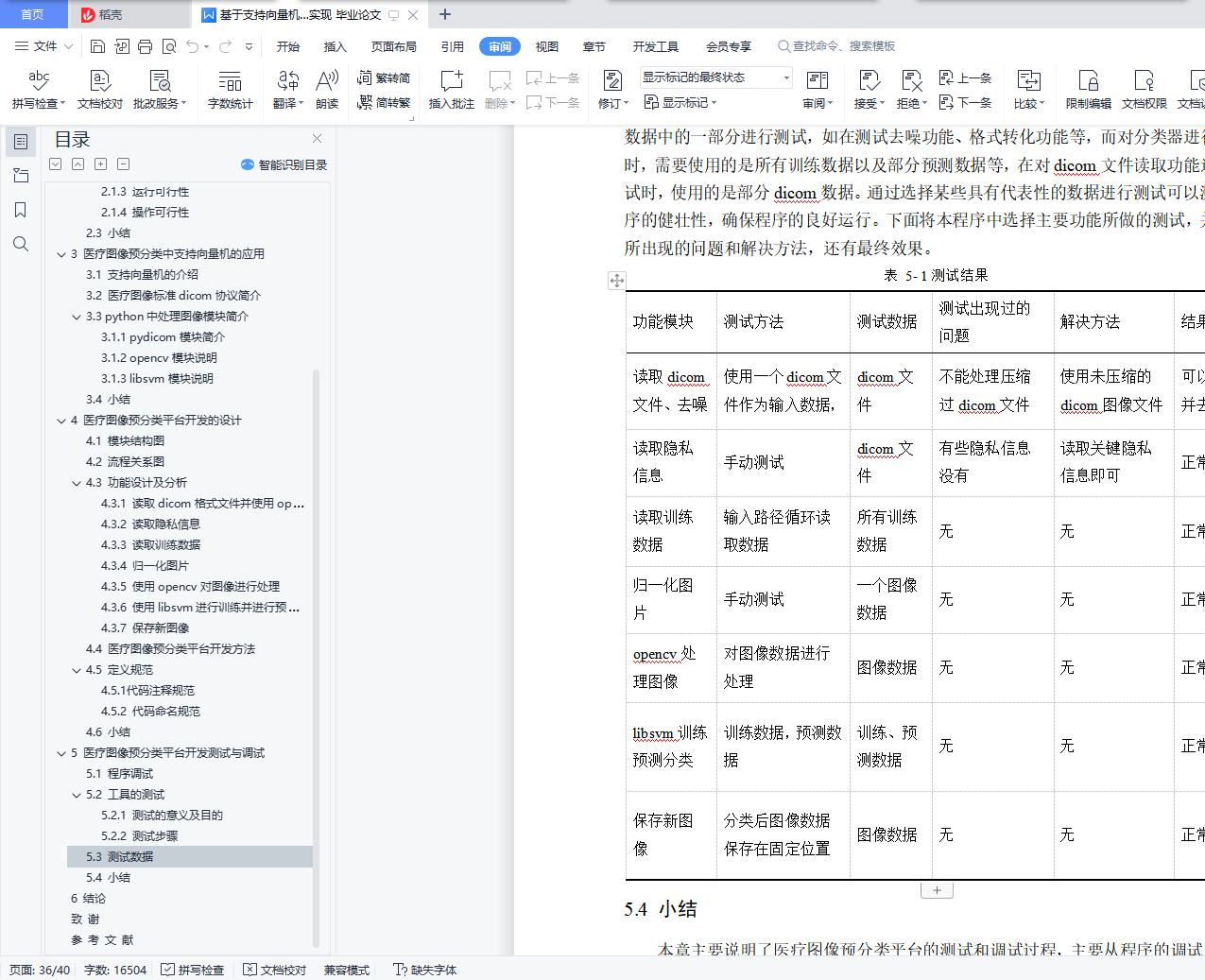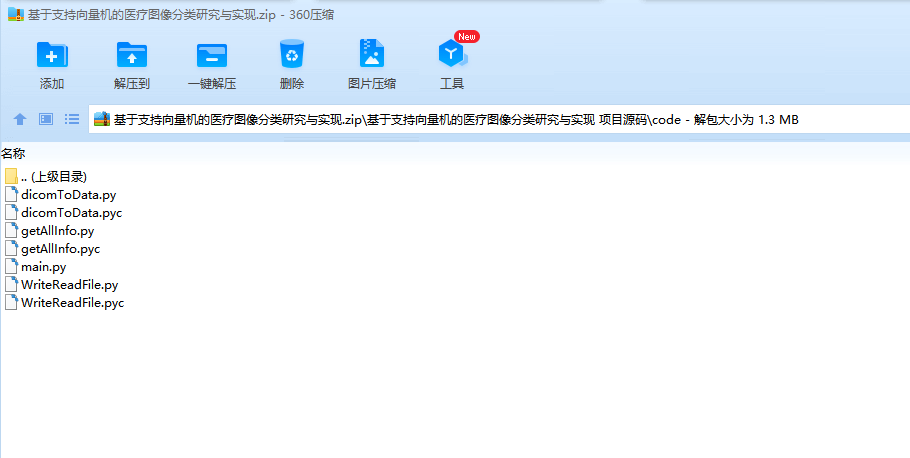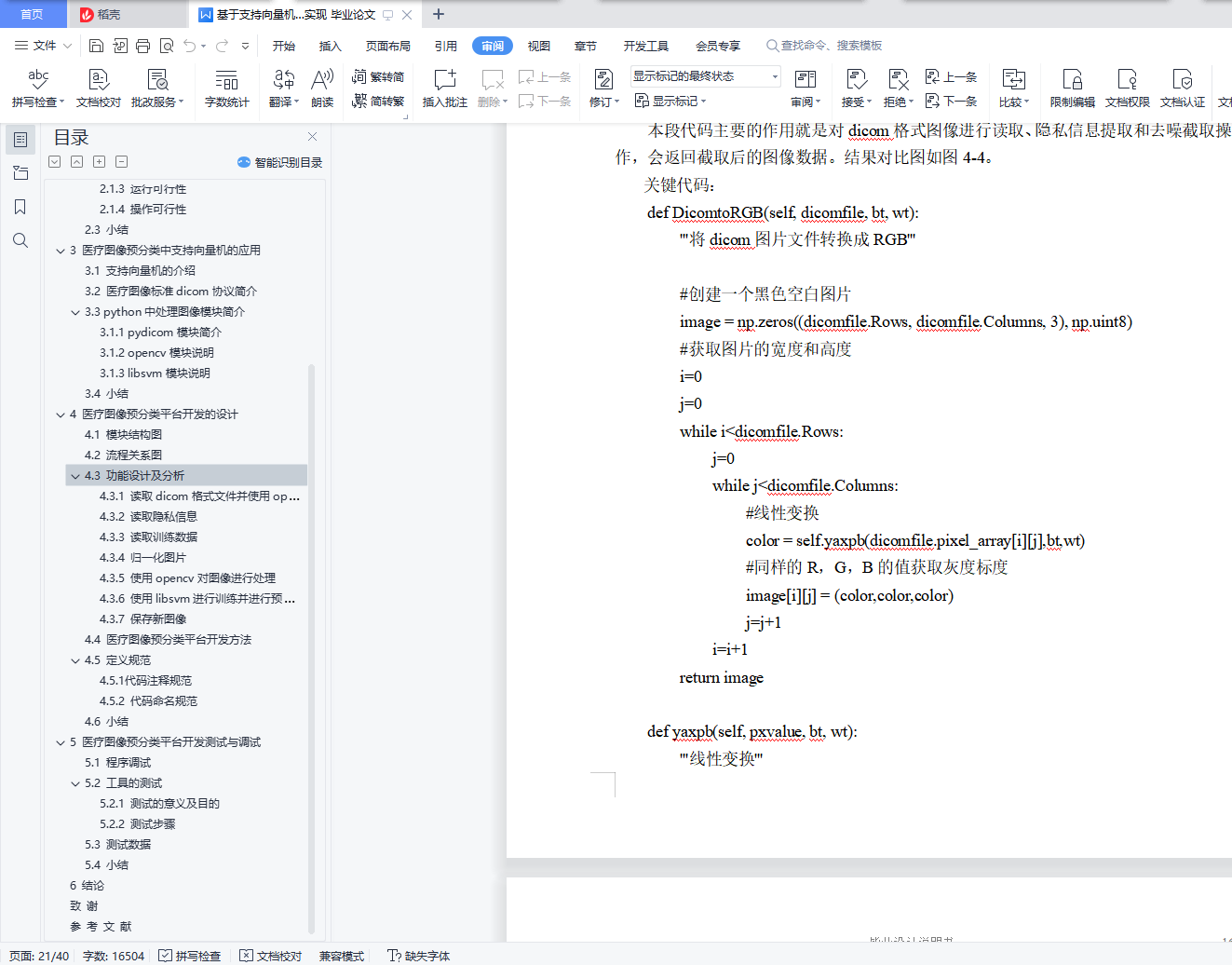摘 要
本文课题设计是基于深度学习中支持向量机算法的医疗图像预分类平台的开发与实现。现阶段,医疗图像中病情的确认都由医生进行判定,从效率方面来讲,人工判断的效率远远小于使用机器学习判断医疗图像中病情的效率,因此,本文课题设计旨在设计实现算法将医疗图像进行分类,产生新的符合机器进行判断的医疗图像。配合使用深度学习中的卷积神经网络经过训练对医疗图像进行一定程度的解读,用来辅助或代替医生诊断病情。使用机器进行病情的判断可以辅助医生判断病情,大大减少医生的工作量,解放生产力。
在实现分类医疗图像的算法过程中,核心是机器学习中的支持向量机算法,开发环境是python环境。由于dicom格式是医疗图像标准格式,因此实现算法的第一步是对dicom格式医疗图像文件进行读取解析,使用python中的第三方模块pydicom模块进行读取解析。读取文件之后需要将数据进行一系列操作转换成可用于分类器分类的格式,本文课题设计中使用opencv模块对数据进行处理,首先进行图像的截取,之后进行灰度化处理、二值化处理,将格式转化为可用于分类的格式。紧接着进行核心操作,即使用分类器进行分类,使用python第三方模块中的libsvm模块对训练集数据进行训练,训练出分类器模型,之后使用训练好的模型对数据进行预测,得出预测的结果。将图像数据分类后,需要进行判断,将正确的分类的图像数据保存到固定的位置,生成新的png格式图像以便于后续的再次使用,这将生产最后的结果,使用python第三方模块中的opencv模块。
本文课题设计的最终结果将会产生新的png格式的医疗图像,生成的新医疗图像是直接截取原始图像的病情部位,去除大量无用信息,实现原始dicom格式医疗图像的有用信息分类转化为易于操作的png格式图像,生成的新医疗图像将被应用到卷积神经网络解读医疗图像病情方面,最终实现病情解读判断效率的大幅度提升,解放生产力。最后会对对程序进行展开分析,展示了程序的设计思路、功能流程及其实现的逻辑,结合程序的源码部分展开描述。
关键词:深度学习,支持向量机,dicom,pydicom,libsvm
ABSTRACT
The design of this paper is based on the development and implementation of medical image pre-classification platform based on support vector machine algorithm in depth learning. At present, the confirmation of the condition in the medical image is determined by the doctor. In terms of efficiency, the efficiency of manual judgment is far less than that of using the machine to judge the condition of the medical image. Therefore, the purpose of this paper is to design and implement the algorithm. Medical images are classified, resulting in new medical images that meet the machine's judgment. Conjugate the use of deep learning in the convolution of the neural network through training to conduct a certain degree of interpretation of medical images to assist or replace the doctor to diagnose the condition. The use of the machine to determine the condition can help the doctor to determine the condition, greatly reducing the workload of doctors, the liberation of productivity.
In the process of implementing the classification of medical images, the core is the support vector machine algorithm in machine learning, and the development environment is python environment. Since the dicom format is the standard format for medical images, the first step in implementing the algorithm is to read the dicom format medical image file and use the third-party module pydicom module in python for reading and parsing. After reading the file, you need to convert the data into a series of operations that can be used in the classification of the classifier. In this paper, the opencv module is used to process the data. The image is taken first, then the gray scale is processed and binarized , The format into a format can be used for classification. Followed by the core operation, that is, using the classifier to classify, use the libsvm module in the python third party module to train the training set data, train the classifier model, and then use the trained model to predict the data, result. After sorting the image data, it is necessary to make a judgment, save the correct sorted image data to a fixed location, generate a new png format image for subsequent re-use, which will produce the final result using python in the third party module Opencv module.
The final result of the design of this topic will produce a new png-style medical image, the new medical image generated is a direct removal of the original image of the disease site, remove a large number of useless information to achieve the original dicom format medical image useful information into easy to operate The png format image, the generated new medical image will be applied to the convolution of the neural network to read the medical image of the disease, the ultimate realization of disease interpretation to determine the efficiency of a substantial increase in the liberation of productivity. Finally, the program will be carried out on the analysis, showing the program design ideas, functional processes and the realization of the logic, combined with the source part of the program to start description.
Key words:deep learning, support vector machine, dicom, pydicom, libsvm
目 录
摘 要
ABSTRACT
1 绪论
1.1 基于深度学习的医疗图像预分类平台
1.2 研究意义
1.3 论文结构
2 医疗图像预分类平台需求分析
2.1 医疗图像预分类平台的需求分析
2.2 医疗图像预分类平台的可行性分析
2.1.1 经济可行性
2.1.2 技术可行性
2.1.3 运行可行性
2.1.4 操作可行性
2.3 小结
3 医疗图像预分类中支持向量机的应用
3.1 支持向量机的介绍
3.2 医疗图像标准dicom协议简介
3.3 python中处理图像模块简介
3.1.1 pydicom模块简介
3.1.2 opencv模块说明
3.1.3 libsvm模块说明
3.4 小结
4 医疗图像预分类平台开发的设计
4.1 模块结构图
4.2 流程关系图
4.3 功能设计及分析
4.3.1 读取dicom格式文件并使用opencv去噪
4.3.2 读取隐私信息
4.3.3 读取训练数据
4.3.4 归一化图片
4.3.5 使用opencv对图像进行处理
4.3.6 使用libsvm进行训练并进行预测分类
4.3.7 保存新图像
4.4 医疗图像预分类平台开发方法
4.5 定义规范
4.5.1 代码注释规范
4.5.2 代码命名规范
4.6 小结
5 医疗图像预分类平台开发测试与调试
5.1 程序调试
5.2 工具的测试
5.2.1 测试的意义及目的
5.2.2 测试步骤
5.3 测试数据
5.4 小结
6 结论
致 谢
参 考 文 献



EUL5Q89CIQ{_O7ZTW9}M.png)
![]()








